Barford Watermill and The Animal Feed Mill
The Hemmings Family of Barford
Carole Whiteley edited extracts from the GCSE work written in the 1970's by G.Smith called "The Village of Barford and "The Old Mill byThe Stream", by Albert Smith and Business Life, Coventry Evening Telegraph Monday 1st December 1980.
Site of the old water/corn mill
The padlocked gate, to the left of Avonside marks the way to the site of Barford Water Mill – a picturesque landmark which stood on a beautiful stretch of the River Avon. At the time of the Domesday Survey in 1068, “Bereforde Mill” was valued at “2 shillings and 13 sticks of eels”. A stick consisted of 25 of these extremely nourishing fish which were attracted to the spilled grain. It passed through the hands of Bordesley Abbey and the Ward family and was purchased by Francis, Earl of Warwick some time before 1760. John Beale a noted benefactor of the village in the 1670’s was the miller and built the Old Mill House opposite. It was run by Oldhams, in conjunction with various partners, from 1845 to 1916. At one point it had a turbine to generate electricity probably in a similar way to Warwick Castle. This was supplied to the village at 210 volts and was also used in street lighting as early as 1917. This meant that Barford was ahead of its time as the village also had gas from the gasworks near Oldhams transport with a second gasometer at Barford Hill. In 1916 James Hemmings became miller but the corn mill ceased working in 1924 having become unsafe. It was handed over free of charge by the Earl of Warwick to the Severn Catchment Board so the authority could carry out a scheme to reduce flooding between Warwick and Barford. The Mill was demolished in the 1950s
Hemmings take over the mill
When Warwickshire farmer James Hemmings decided in 1905 to buy an old watermill to grind his grain, he can have had little idea of what he was starting.
For 75 years later J. E. Hemmings and Son Ltd was a multi-million-pound animal feed enterprise with one of the most advanced plants of its kind in the country.
From the start, James Hemming” proved ‘a master of what is now called business integration.
As the owner of the village store at Barford, the mill meant he could grind corn from his nearby farm to flour, then sell fresh-baked bread to the locals.
Before long, other local farmers brought their grain to him, and what had started as a sideline became the backbone of a thriving family business. His son, Dick Hemmings, developed an absorbing passion for mechanics.
Wartime Service
After serving an apprenticeship with a Coventry engineering firm, Dick Hemmings was called up for service in the First World War and he played a decisive role in the development of the synchronised machine gun firing mechanism. This gave British airmen the big tactical advantage of being able to fire through their propellors.
Pig Farming and the development of animal feed
After the war Dick returned to Barford and took a hand in his father’s water mill. He also discovered a late love of farming and set up a piggery near the village. It proved a fortuitous move as it led Dick to experiment at the mill with producing food for his pigs.
He succeeded royally. So much so that fellow farmers were soon lining up to buy his surplus feed , just at the time when the milling business was set for decline owing to the advent of modern motor-driven mills.
Hemmings became the first firm to bring combine harvesters and grain dryers to Warwickshire. This meant they could cut, dry, market and even mill customers’ grain and led to their expanding the business far beyond the sleepy village whose needs it had originally been set up to serve.
New location for Barford Mill
In 1924 the mill changed its location to Mill Lane (previously Red Lion Lane).
Innovative and set slap in the middle of its own prime market, the newly discovered animal feed business grew by leaps and bounds.
Bumper Harvest
One time the bumper grain harvest helped to prevent the cost of many feeds rising substantially. Demand for the firm’s products remained fairly constant. Never the less, Mr Hemmings was anxious in case declining living standards continued to be reflected in a falling demand for meats, as this would cause farmers’ feed needs to fall off.
Costly Hardware
This costly hardware was essential because mixing modern feed was a highly scientific business. Gone were the days when the firm’s production method was simply to mash together a shovel 0′ this and a bag 0′ that.
Hundreds of different feeds were mixed and each was graded to suit particular animals of specific ages, providing finely- tuned balances of proteins, minerals, carbohydrates and vitamins. Sometimes, even medicines were blended in to help to compare prevalent diseases.
David Hemmings takes the business forward
Dick’s son David, became managing director, he took an early fancy to the animal feeds business. Conscripted into the RAF, he even managed to get a compassionate posting to Wellesbourne, where he become a Serviceman by day and a businessman at night.
The business became a full time occupation for 49-year-old David. It had an annual turnover in the region of £5 million and 50 employees in plants at Barford, Southam and Alcester who used the most advanced computerised blending techniques available.
One of the firm’s more novel products was made at their Southam mill. It used waste human food, mostly sub-standard potato crisps and biscuits, to produce about 200 tonnes of high fat feed each week.
During this time, Mr David Hemmings, who continued to live in the village, was also a Parish Councillor and School governor.
His staff at Barford Mill in Mill Lane consisted of
5 top staff
3 lady office workers .
5 Representatives
The production Team consisted of
Four workers plus one Foreman
3 packers
4 Warehousemen
1 Siloman( bulk grain)
11 Drivers…11 lorries
2 Fitters and Maintenance men
Three shifts were worked 16 hours a day five days a week + Saturday mornings 6am-12noon.
70% of the labour force was from the village the rest from Wellesbourne and other villages in the area.
Manufacture
Cattle Pig and Poultry foods were made here. 22,000 tons was produced at the mill per year. The biggest production was in the winter when 2,000 tons of food was produced per month, but this dropped off in the summer. The food being grazing nuts and milk nuts. Most of the food was bagged about 20% was bulk mostly in poultry food.
Grain and raw materials cost about £19-22 per ton to haul and £33 per ton delivered. Most of the grain was bought off local farmers.
Ground nut and cotton cake were imported and hauled from Avonmouth. American maize and fish meal from Iceland were hauled from Cornwall.
Customers were in about a 50 mile radius of Barford. There were a few in Cornwall so when a load of meat bone-meal was being collected a load of the mill produce was taken saving a journey.
At one time nearly all the produce was collected but later most was delivered.
Five years ago a new plant was built.
The drivers were the first line of sale so a higher wage was paid to the drivers.70% did not help unload but they all helped load their own lorries.
Development
A simple computer for costings saved much time.
A lab was built because finished products and raw materials had to be sent to Liverpool to be analysed.
By law oil and protein rations had to be shown on the bag.
A weighbridge took 300 tons this saved much time.
Any building work was done by Mr B Foster and electrical work by Clarkes of Wellesbourne.
In the long term, the firm met expanding orders. Following the opening of their facilities in Broom Mill, near Alcester in 1975, they had plenty of unused capacity and almost tripled their weekly output of 700 tonnes without building new works.
There was a strong philosophy behind Mr Hemming’s big Alcester Mill: ”I believe sooner or later one government or another is going to put common sense before politics and allow the farmers of this nation to provide most of its food needs,” said Mr Hemmings.
“At present we are in the ridiculous position of importing about 50 per cent of our food needs when we could produce nearly all these items more efficiently ourselves. Something tells me this will not always be the case.”
Problems in the EEC
The EEC, he believed, had not been a good thing for British food production. “It simply cannot be tuned properly to produce the right amounts for the community as a whole. That’s why we get butter mountains and, pig-meat problems. It’s difficult enough to organise a nation to produce the right agricultural goods at the right time. When you are trying to co-ordinate a number of different nations to do it the problems are massive.”
One cannot help but feel the Mr Hemmings business policy would have gained grandfather Hemming’s approval; British grub for British people.
The End of an Era Thursday 30th September 1988
One of Barford’s oldest businesses closed after trading for more than 80 years.J E Hemmings, bulk poultry feed manufacturers was set up in a watermill in 1905 by the village baker James Hemmings.
Over the years the business had became more automated and until recently employed 28 staff.The founder’s grandson, chairman and managing director David Hemmings is retiring for personal reasons.”I wanted to sell the business as a going concern, but no-one was interested. Now I think the property will probably be sold off for residential development. The goodwill of the company will go to a farmer’s co-operative society in Worcester. Many of our customers will go there. Then we shall just cease trading.”
The land and buildings were sold by tender on October 21st by Birmingham estate agents Henry Butcher.
The land was built on by Carla Homes and the cul-de-sac of homes was called Hemmings Mill.

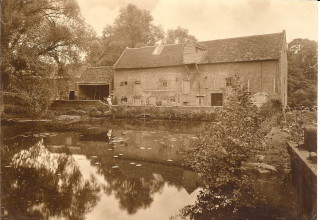
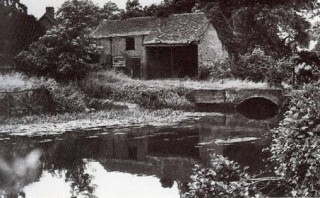


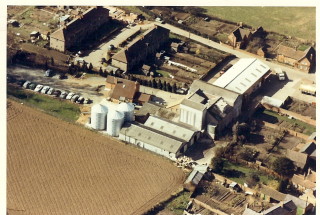
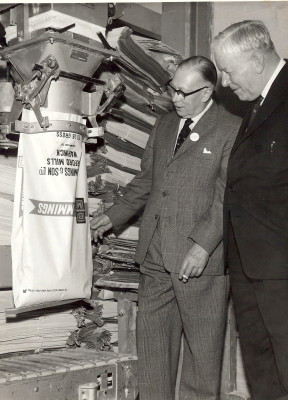



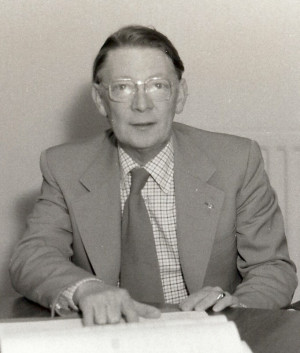
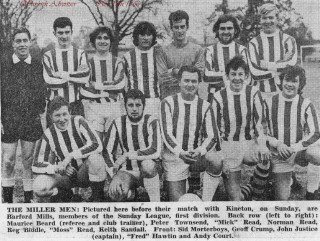




Comments about this page
I remember me and my Dad used to come to Hemmings Mill and we used to deliver corn on behalf of Lampreys of Banbury.
I really miss those days.
I have fond memories of this mill when I was a child….My dad Paul Barnes was a lorry drivers mate who worked there in the 70’s.My nan Dolly Barnes Also worked as a cleaner there with her best friend Jean Smith. My dad always said that David Hemmings was a great boss and it was such ashame when the mill ended.
Dear Emily, Thank you for contacting Barford Heritage Group. It is always interesting to learn more about Barford and the mill in past years. It was a shame that the mill ended as there had been a mill in the village for centuries and it had been a major employer. It would be great to get more reminiscences from your Dad so that his story is not lost.
With kind regards,
Ann
I Worked at Barford mill from 1966 through to its closure 1988. I started as a lorry driver, after moving from Oldham’s Livestock transport, just up the road.
In 1968, just at about the time the Company entered an expansion, through a contract to Agricultural Central Traders (A.C.T) group and, through my wish to progress with the company. David Hemmings willingly, gave me that very opportunity and, so, my ‘in house’ training began. Learning, by experiencing each and every stage & aspect of the production requirements,from the ‘back shed’- batching bagged ingredients, to operating the steam boilers – the cubing process & production machinery – the intake grain silos -batching and grinding the grain and bulk materials, eventually, rising to shift chargehand/foreman. 2x shifts, 06.00>1400. and 1400>2200.hrs
In 1971, I joined lower management as ‘Materials controller’ and, my 1st office ! I worked closely at times with Mr. John Keys (buyer and nutritionist) It was at about this time , when it was decided to create a football team. I took position of Manager, and named the team the ‘Miller Men’, we joined the local Sunday football league and immensely enjoyed the great fun.
In 1975, I was promoted, to the position of Transport & Garage operations Manager. Later, in this period ,I befriended a lovely lady, (Jane) from the accounts office and, we married 3rd September, just before the closure of the Mill on 28th September 1988. My wife and I are now 12 years into retirement, but, unfortunately, many of our former colleagues, have now passed on.
I immensely enjoyed all 22 of my years at Barford Mill, together with other employees, all of whom contributed to the best years of my working life. David Hemmings, was wonderfully inspiring, generous, thoughtful man and employer, who genuinely cared about his staff, most of whom were of long service. He once said to me, and I quote, – “there is, ‘no them and us’ Paul,-we are a team- a loaf of bread is the same cost to a poor man as it is to the rich”-unquote. **(good pun, coming from a Bakers Grandson, I thought).
I well remember him taking his wife ‘JO’ on holiday to Mexico or( somewhere such) from where he would ‘phone every day. We told him-‘don’t worry Boss! everything is fine- we are a team, remember?- the mill won’t stop, just because you are not here. Just relax and enjoy your holiday!
I do know (now) that it broke his heart, for him, as the 3rd generation, to finally sell the Business out. He told me, that, he in someway felt guilty and, that he had failed both his Grandfather and his father, by having to do so. He had also felt great remorse for all the dedicated loyal staff job losses. Although we were all made redundant, we, non of us, could help feeling much sorrow for him in his time of distress.
I shall, forever, be thankful to David, for all his considerations and, personal help to me, through a very difficult, stressful private time.
R.I.P David Hemmings. (now resting peacefully in Barford cemetery)
14/10/2019
My dad, John Keys worked for David from 1967 to 1988 , always enjoyed it. I have fond memories of meeting David and the family at the Royal Show every year where Hemmings ran the Poultry Unit. Very much a family business.
Dear Andy,
Thank you for your comment, it is always lovely to hear from people with connections with our village. If you have any more memories of the Mill or the Hemmings family we would like to hear them. Any photos of your Dad working in the mill or the Hemmings family at the Royal Show would be much appreciated as we could share them with the older residents of the village who, no doubt, some of them will will have worked in the mill as well.
Thank you and we look forward to hearing from you again.
With kind regards,
Ann (Barford Heritage Group researcher)
David Hemmings was my grandfather. I remember visiting the mill when I was a small child. It’s nice to see people speak fondly of him. He was a lovely man whose entire life was spent living in Barford.
I see the comment about Bob who I remember well from his day’s gardening at my grandparents house, Debden Hollow
Dear James,
Thank you for your comment on our Heritage web page. We are always delighted to hear from people who have a family connection with Barford. We would love to learn your memories of the mill and of your grandfather. We have a project at the moment writing up the histories of families who had a long association with the village and the Hemming’s family certainly do.
We look forward to hearing from you again.
With kind regards,
Ann (Barford Heritage Group researcher)
There were three of us from my family worked there. I worked in the Accounts dept., 1973 to 1977 my brother Philip Holton worked on the cuber in the seventies and my dad Bob Holton was there until he retired in 1986. He worked in Mr.Hemmings garden for years after that. David Hemmings is the only man I’ve seen using a manual typewriter and he was quick! I was impressed!
Thank you Angela, Barford Heritage Group are always interested to hear from past residents or people who worked in our village.
With kind regards,
Ann
I worked at Hemming and Son from 1974 to 1978 when I left to work in Zambia. I was a employed to look after the equipment with Wag Higgett I was there when he retired, what a great inspiration he was. I spent a lot of time over at Broom when David Hemming\’s purchased the Adkins and Thomas mil, stripping out the old and installing new equipment.
David Hemming was a gentleman I loved my time there and have fond memories.
Kind Regards Jerry Cleal
Before he did his national service, David Hemmings was a pupil of my father Robert Spalton of Charles Spalton & Sons Ltd, Ashbourne Road Mills, Derby. He lived in the mill house with us and had a room in the attic. I was four and my sister Sue was ten. He rather livened things up for us and was great fun. It was quite a treat for us to visit Barford. Mr & Mrs Hemming sir were very kind and I can still remember the Hemmings’ phone number of those days Barford 240 . Strange what sticks in your mind. Our mill too is now redeveloped as flats although part of the building was preserved.
i worked there for a short time in the early 70s as a lorry driver and found mr hemmings (david) a good boss to work for,
I worked at the feed mill. The filling hopper picture shows Andrew Court and Victor (Mick) Read. The stitching machine picture shows Victor (Mick) Read.
The steam press (also called a cuber) was used to turn the feed mush into pellets.
Add a comment about this page